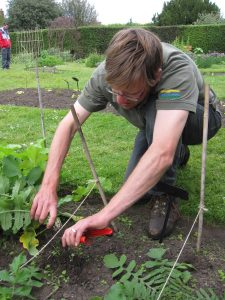‘Really Wild Veg’ is a vegetable growing trial run by the Edible Gardening Project and four other community gardens – Girvan Community Garden, Good for Ewe, Whitmuir Organics and Applecross Community Garden. The project is exploring how domestication has changed three familiar plants – cabbage, beet and radish – from wild plants still found in coastal places in Scotland to widely grown crops. We know that domestication alters plants appearance and taste. What we must not forget is that crop wild relatives (CWRs) are important sources of genes for breeding new and improved crop varieties. New research is showing the importance of crop wild relatives and pointing out how poorly known and conserved these genetic resources often are.
On 23rd April seeds of wild cabbage, sea beet and sea radish were sown along with a heritage variety and a modern day F1 hybrid. Details of the sowings can be seen here. Since then the radish were harvested on 26th June and the beet on 16th July. At the time of harvest the productivity was assessed by weighing ten plants minus the roots. This has provided some surprising results. It might be expected that wild plants would be less productive than domesticated crop plants. In the case of sea radish this was very much the case with only 900g of fresh weight compared to 1,850g for the heritage variety and 2,000g for the F1 hybrid. However, with beet the result was reveresed and the F1 hybrid came in lowest at 1,500g, next most productive was the heritage variety with 1,900g and wild sea beet came out best with 1,925g.
Another assessment made at the time of harvest was a subjective test of taste based on fresh leaves. It would have been better to taste cooked leaves as all these plants would normally be eaten cooked, but what the results have shown is that taste did vary markedly between the crop plants and the wild relatives. In the case of radish the crop varieties grown are what is called leaf radish grown as a leafy green and not a root crop. Both varieties had a mild flavour and palatable texture. The sea radish had a much more pungent ‘radishy’ flavour. Texture was less appealing as the leaves are very hairy! In the beet texture was more uniform, but flavour was least popular in the wild plant as it was too strong and bitter compared to the domesticated crop.
The strong flavours of the wild plants may indicate the presence of phytochemical compounds that are often lost in the process of plant breeding. Many phytochemicals are considered to be beneficial for our health in terms of protecting us from serious diseases such as cancer and cardiovascular disease. This aspect of ‘Really Wild Veg’ is being investigated by the Rowett Institute for Nutrition and Health. Detailed analysis of the compounds present in the plants will provide a valuable insight into the impact of plant breeding on human health. As well as phytochemicals, important nutrients such as protein, fibre, vitamins and minerals will provide critical information to breeders, growers and health conscious consumers.
In terms of resistance to pests and diseases no conclusions can be drawn so far as none of the trial plants in Edinburgh has shown an recordable symptoms. A testament to the growing skills of the Edible Gardening Project.

